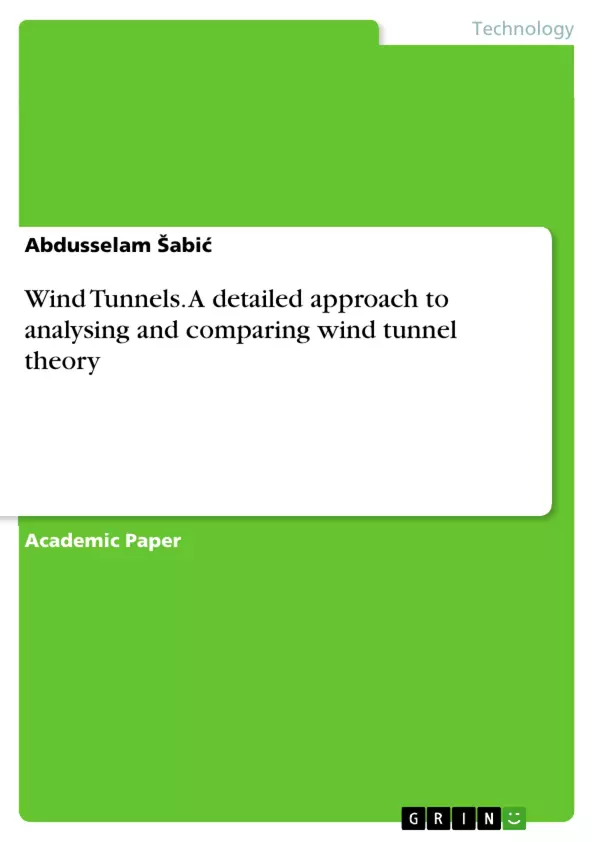Wind tunnels are a great way of obtaining precise and accurate data on an aerofoil or model aircraft. They are crucial because they help engineers save a lot on resources; rather than having to make a full prototype by "winging it", as they say, with a wind tunnel, it is possible to test a collection of low-cost models prior to the prototyping stage in order to find the best configuration for a design.
As such, this assignment will cover the operation of wind tunnels from multiple points of view, looking at the various uses of a wind tunnel both from theoretical and practical points of view.
Inhaltsverzeichnis (Table of Contents)
- Introduction
- Task 1 wind tunnel types.
- Subsonic wind tunnel..
- Transonic wind tunnel..
- Advantages of low-speed wind tunnels.
- Open return wind tunnel..
- Closed return wind tunnel..
- Disadvantages of low-speed wind tunnels.......
- Open return wind tunnel.
- Closed return wind tunnel..
- Supersonic wind tunnel....
- 1. Introduction......
- 1.1 Experiment 1 – Wind tunnel calibration.
- 1.2 Experiment 2 - NACA 2412 aerofoil with variable flap..
- 2. Objectives......
- 2.1 Experiment 1 - Wind tunnel calibration ......
- 2.2 Experiment 2 - NACA 2412 aerofoil with variable flap………………..\n
- 3. Theory..
- 3.1 Experiment 1............
- Measuring velocity using a pitot probe.
- Measuring pressure distribution using a manometer.......
- Boundary layer theory
- Force coefficients from distribution of pressure....
- 3.2 Experiment 2....
- Aerofoil theory - forces on an aerofoil.......
- Drag force equation ........
- Lift force equation.
- Pitching moment equation ........
- High lift devices........
- 4. Instrumentation used on the wind tunnel.
- 5. Precautions and procedure.....
- 5.1 Precautions...
- 5.2 Procedure ......
- 5.2.1 Experiment 1 – reference velocity.
- Experiment 1 - Velocity profile .......
- 5.2.2 Experiment 2 - NACA 2412 variable flap aerofoil.
- Starting the wind tunnel.
- Inserting the aerofoil model.
- Wind tunnel test procedure
- 6. Results and discussions
- 6.1 Experiment 1.....
- 6.1.1 Reference velocity.
- 6.1.2 Velocity profile .......
- 6.2 Experiment 2...\n
- 7. Sources of error
Zielsetzung und Themenschwerpunkte (Objectives and Key Themes)
This assignment focuses on the operation and practical applications of wind tunnels, providing a theoretical and practical understanding of their use. It explores the different types of wind tunnels and their specific applications, including subsonic, transonic, supersonic, hypersonic, and hypervelocity wind tunnels.
- Wind tunnel design and operation
- Aerodynamic principles and their applications in wind tunnel testing
- Experimental procedures and data analysis in wind tunnel research
- The role of wind tunnels in aircraft design and development
- Applications of wind tunnels in other fields, such as automotive, maritime, and civil engineering
Zusammenfassung der Kapitel (Chapter Summaries)
The text begins with an introduction to the importance and role of wind tunnels in aircraft design and testing. It then explores the various types of wind tunnels, particularly focusing on subsonic and transonic wind tunnels, outlining their advantages and disadvantages. The text delves into the construction and operation of a typical subsonic wind tunnel, outlining the various components and functions. It also explores the specific applications of subsonic wind tunnels in testing aerofoils, boundary layers, and other aerodynamic phenomena.
The text then moves on to describe the two experiments conducted in the wind tunnel: calibration of the wind tunnel and testing of a NACA 2412 aerofoil with a variable flap. It provides a detailed explanation of the theoretical principles behind each experiment, including the theory of air flow, boundary layer theory, aerofoil theory, and the calculation of drag, lift, and pitching moment forces. The text also covers the instrumentation used in the wind tunnel, the procedures for conducting the experiments, and the precautions that need to be taken. Finally, it discusses the results and analysis of the experiments, highlighting potential sources of error.
Schlüsselwörter (Keywords)
This text explores the application of wind tunnels in various fields, focusing on their use in aerodynamic research and testing. Key themes include the different types of wind tunnels, their design and operation, the fundamental principles of aerodynamics, experimental procedures, and data analysis. It also covers the application of wind tunnels in aircraft design, as well as other fields like automotive, maritime, and civil engineering.
- Quote paper
- Abdusselam Šabić (Author), 2021, Wind Tunnels. A detailed approach to analysing and comparing wind tunnel theory, Munich, GRIN Verlag, https://www.grin.com/document/1264786




